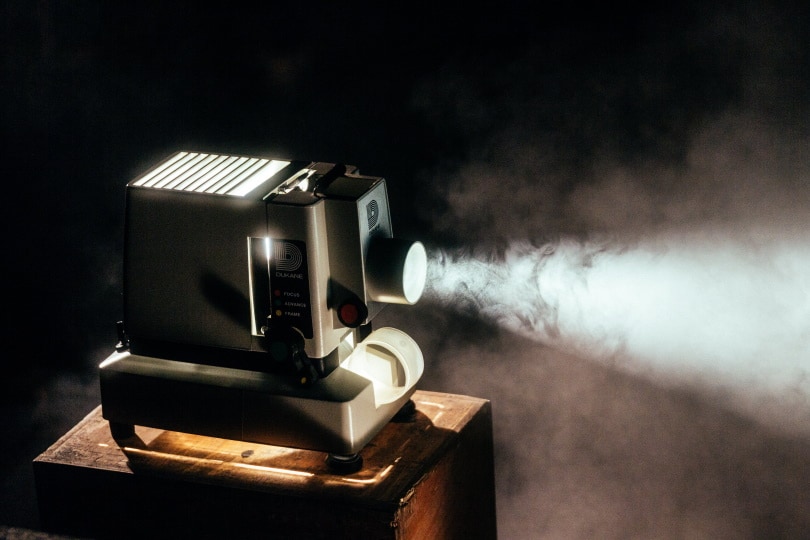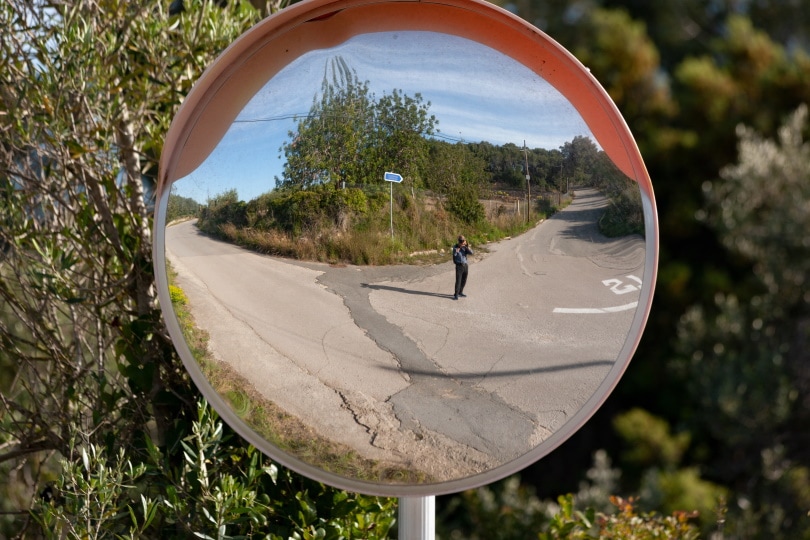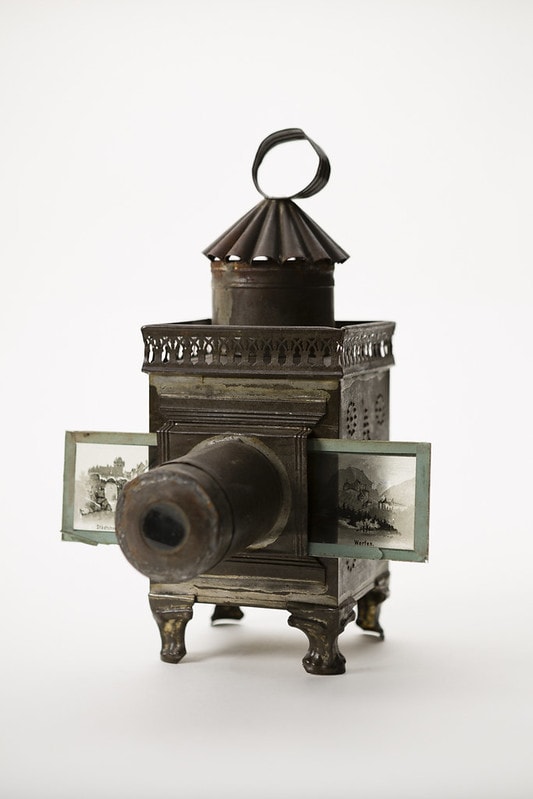When Were Projectors Invented? History of the Projector
Last Updated on

Projectors have a bit of a complicated history. When they were invented depends largely on what you mean by a “projector”. For instance, very early forms of primitive shadowgraphy likely date back to prehistory. These can include projectors, but they likely didn’t always include projectors.
Low-cost opaque projectors were not produced until the 20th century. However, at this time, they were marketed as toys for children. Overhead projectors were invented in the late 1950s and slowly began to be used in schools and businesses.
Many types of projectors existed over the years. We’ll take a look at some of the most common options in the order that they appeared. Which one you count as the first projector is completely up to you!

1. Camera Obscura

After shadowplay, the camera obscura is probably the next instance of a projector. This is a natural optical illusion that happens when an image of a scene is projected through a small hole in the form of an inverted image. A smaller hole provided a sharper image.
In some form, this device was the ancestor of the camera. However, the shared history of the projector and camera split sometime later with the introduction of the magic lantern in the 17th century.
After the introduction of the camera, the camera obscura was mostly used as a drawing aid.
2. Chinese Magic Mirrors

Chinese magic mirrors are the oldest known object that could actually project an image. These mirrors have been traced back to the Chinese Han dynasty, though we do not know exactly when they were invented. They were also found in Japan.
The mirrors were made in bronze with a pattern on the back. Then, a mercury amalgam was laid over the polished front. When the light was reflected from the mirror onto a surface, the pattern underneath could be seen. You could not see the pattern by looking at the reflective mirror, though. Therefore, they appeared to be “magic.” The pattern looked like it came from nowhere.
3. Concave Mirrors

Concave mirrors can invert a real image of an object and appear to project it. When done correctly, a very convincing optical illusion of the object appears. The earliest use of this method appears in 1275 by a French author. This technology was developed as a drawing aid and was available as early as 1430.
Some have argued that the use of concave mirrors may be the cause of some encounters with spirits. However, we have no evidence of this. We do not know exactly when this method was invented.
4. Fontana’s Lantern
This device was described in a 1420 book by engineer Giovanni Fontana. Basically, a lantern was used to project light through a hole that looked like a demon, which would project the image of a demon onto a wall.
However, the drawings and the machine instructions don’t seem to add up. It is unlikely that the machine would produce an image as clear as the author describes in the book, as this would have been a simple use of outlined light.
5. Alberti’s Projector
In 1437, it is possible that Leon Alberti produced a projector that projected painted pictures from a small box with a hole. However, the description is unclear. We do not know if this machine was a type of projector or if the user put their eye up to the hole to see the image.

16th Century
In the 16th century, Leonardo da Vinci was thought to have built a projecting lantern, which included a lens, candle, and chimney. However, this is based on a sketch and not a report of the actual work.
Later, Agrippa wrote in his book that it was possible to project images or written letters onto the surface of the moon using the moonbeams. Evidentially, Pythagoras was also known for having done this trick.
In 1589, Gaimbattista della Porta published information on the ancient art of using a projecting mirror in his book.
Cornelis Drebbel was thought to have some sort of projector. We have a letter from 1608 where he described apparitions that he was able to summon with a new invention. He later invented the microscope, so playing with mirrors was likely not uncommon for him.

16th, 17th, and 18th Century
Physicist Daniel Fahrenheit constructed a solar microscope a few years before his death. This device was basically a microscope combined with a camera obscura. It used bright sunlight as its light source to create a clear, magnified image.
Fahrenheit may have shown this instrument to German physicist Johann Lieberkuhn, who later introduced the invention to England. The microscope was carefully improved and used in a variety of experiments, some of which appeared in the first issue of the Journals of the Royal Institution of Great Britain.
Later, Leonhard Euler invented a projector that could project a clear image of a small object. This device is now commonly known as the episcope.
In 1780, scientists Jacques Charles invented a “megascope,” which he used in his lectures. Later, projectors were used by a variety of other scientists during lectures and classes.
Present Day Projectors
During the early 20th century, low-cost opaque projectors became available. These projects were originally marketed as toys for children, not for adult use. Episcopes were also marketed as enlargement tools for artists, as they allowed images to be traced on canvas. Usually, the light source for these inventions was limelights.
In the late 1950s, overhead projectors were widely used in schools. The first overhead projector was used by the police for identification work, though. It used a celluloid roll over a stage that allowed facial characteristics to be shown. The U.S. military also used this device for training in 1940.
During the later 20th century, it was common for positive film slides to be shown as a form of entertainment. Family and friends would gather to view slideshows, usually of vacation travels or life events.
As slideshows became more advanced, they were used for marketing and promotional material. These larger systems were projected by multiple projections and then synchronized. Sometimes, they had an audio voiceover.


Final Thoughts
The history of a projector is a bit confusing since there is not always a clear definition. Were the shadow puppets of the stone ages projectors? The definition will differ a lot from person to person, which may cause the history of the projector to differ as well.
Furthermore, we do not know much about early projectors. It is likely that many early projectors were grouped in with magic, and that the creators of this magic did not want to divulge their secrets. Therefore, it is likely that these early inventions never saw the light of day.
Featured Image Credit: Piqsels
About the Author Kristin Hitchcock
Kristin is passionate about helping animal lovers by informing them on the latest scientific research and understandings. She currently resides in Tennessee with four dogs, three cats, two fish, and a lizard, though she has dreams of owning chickens one day!
Related Articles:
When Were Binoculars Invented? History, Today & Future
How to Clean a Refractor Telescope: Step-by-Step Guide
How to Clean a Telescope Eyepiece: Step-by-Step Guide
How to Clean a Rifle Scope: 8 Expert Tips
Monocular vs Telescope: Differences Explained (With Pictures)
What Is a Monocular Used For? 8 Common Functions
How to Clean a Telescope Mirror: 8 Expert Tips
Brightfield vs Phase Contrast Microscopy: The Differences Explained
